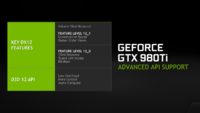It was as I stated earlier, you just misspoke.It does not matter if I confuse the feature set with API. Feature set 11.1 which is part of DX12. This is also where amd 280 cards are compatible or capable up to.. Which makes them sort of half baked. They are not compatible with Feature set 12 or 12.1. That's where the argument started. Do we know up to what feature set Ashes of Sigularity exploits DX12. Im confident that it is beyond feature set of 11.1.
Pendragon1 refuses to agree on that.
I'm going to assume based on his posts that Pendragon thought exactly the same as I did, that you were speaking of the API and NOT the feature level. If you're speaking of the feature level rather than API in the quote above, then everyone is in agreement.You both forget that DX12 is not supported by 79xx or 280 cards which are essentially the same.
GCN 1.0 supports DX12, but doesn't support feature levels 12_0 or 12_1, it only supports up to feature level 11_1.
EDIT: I'll even go as far as to agree with you, GCN 1.0's DX12 support IS half baked. I agree there also
![[H]ard|Forum](/styles/hardforum/xenforo/logo_dark.png)
